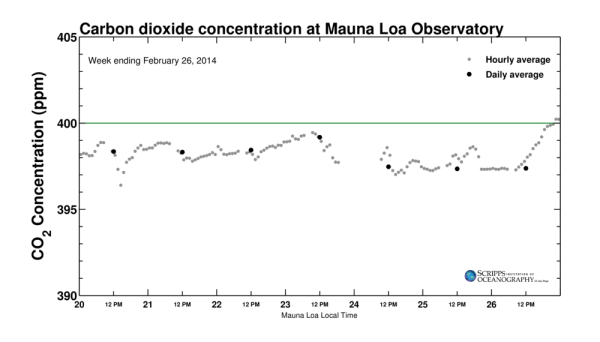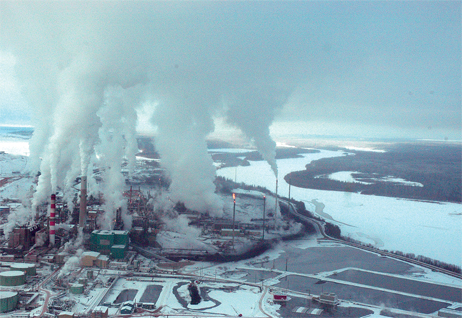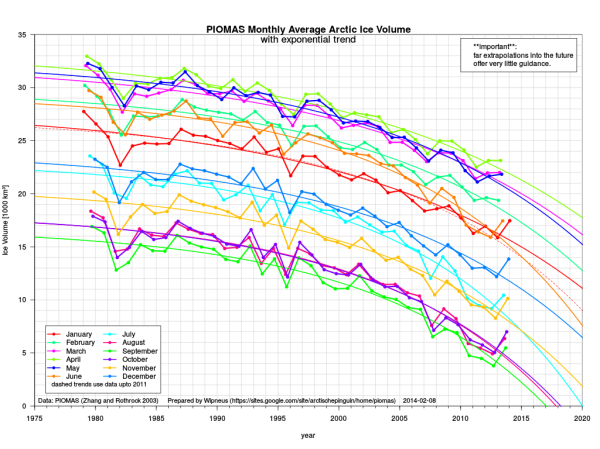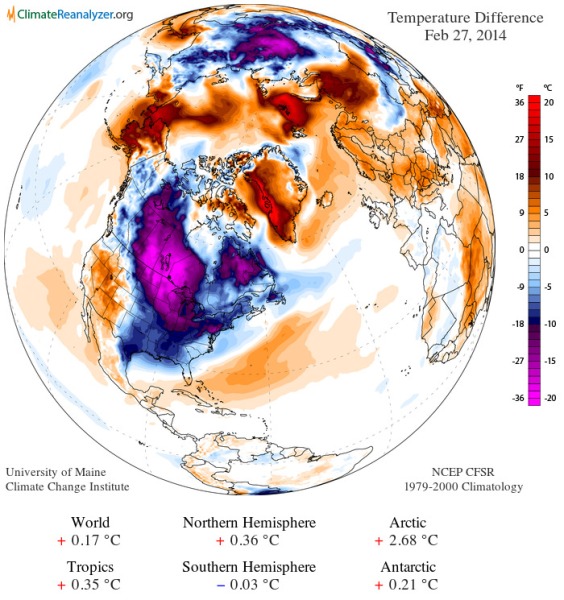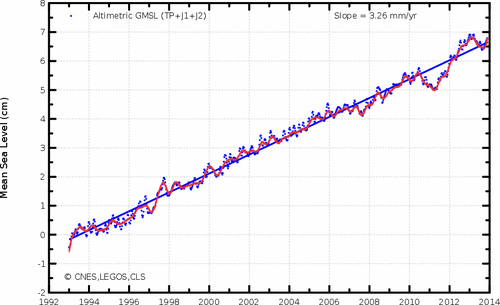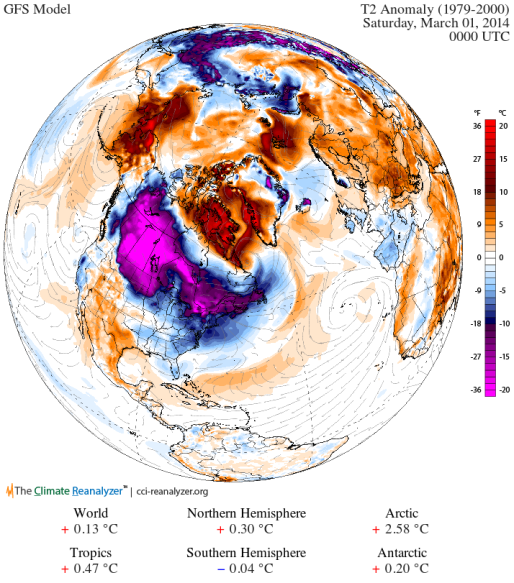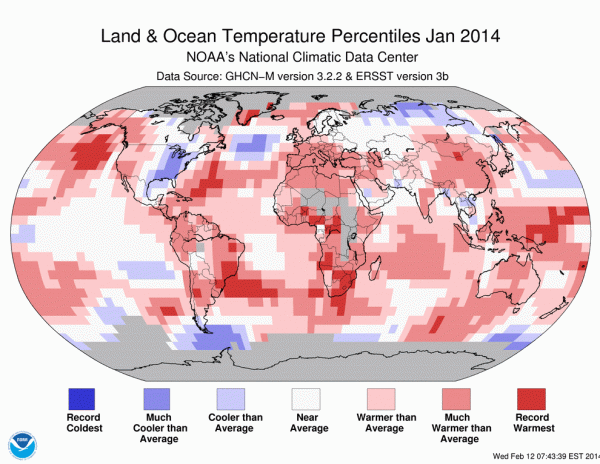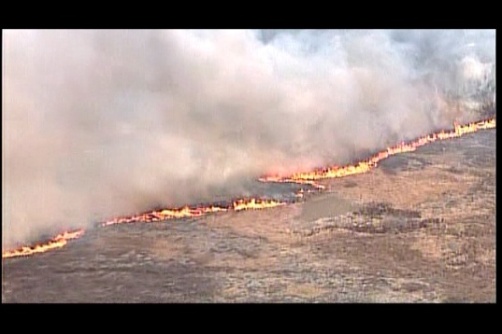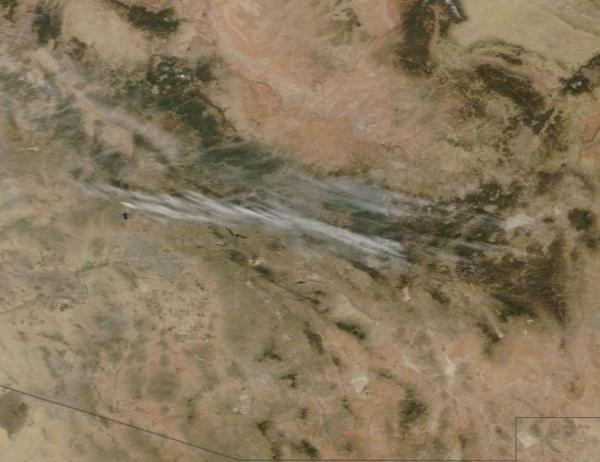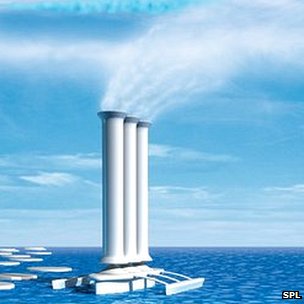(Daily and hourly CO2 readings at the Mauna Loa Observatory from February 20 to 26. Image source: The Keeling Curve.)
More than two months before typical annual maximum in late May or early June, global average CO2 levels have again breached the dangerous 400 part per million threshold.
On February 26th, Mauna Loa’s CO2 observatory recorded three hourly readings at or above 400 parts per million with a peak value of 400.2 ppm. The reading comes just ten months after weekly CO2 values exceeded 400 parts per million during May of 2013, the first time in more than 3 million years that atmospheric levels have been so high.
At the current annual rate of increase, we can expect CO2 levels to peak around 401.5 to 403 parts per million sometime in late May of this year. Last year’s average annual rate of increase was 2.6 parts per million over 2012. If 2014 were to match this, abnormally rapid, pace, daily and hourly measures could exceed peak values of 403 parts per million over the next two months.
A Steepening Rise of Concentration
From the early 1960s the pace of atmospheric CO2 increase was about 1 part per million each year. As human population, fossil fuel consumption, and industrialized agriculture expanded, annual rates of CO2 increase up-ticked to about 1.5 parts per million from 1980 to 2000 and again to slightly above 2 parts per million each year from 2000 to the present. Due to a number of factors including an expected continued increase in fossil fuel burning, the exhaustion of various carbon sinks around the globe, expected changes to ocean and land based photosynthetic life, and the release of various global carbon stores due to amplifying feedbacks related to human-caused warming, rates of CO2 increase are expected to be as much as 7 parts per million or more each year by the middle of this century.
(An ever-steepening curve. CO2 levels from 1700 to the present. Image source: The Keeling Curve.)
Current Pace of Emission Without Precedent
The current pace of emission has no corollary in the geological record. Based on best observations, the fastest CO2 increases in the past were during either the PETM extinction event of 55 million years ago or the Permian Extinction, or Great Dying, of 250 million years ago. During these periods, rapid rates of CO2 increase were observed at about .35 parts per million each year. The current pace is now six or seven times that seen during these dangerous geological epochs and expected rates of CO2 increase during this century could exceed 20 times that seen in the record.
It is worth noting that more than 32 billion tons of CO2 now go into the atmosphere each year and that this rate of emission alone is about 160 times that of volcanic emissions the world over. Total human carbon emissions in CO2 equivalence for all greenhouse gasses is now over 50 billion tons, or more than 200 times global volcanic emissions. Even an epic flood basalt on the order of that which appeared during the Permian Extinction couldn’t match the current pace of human emission.
(CO2 emissions through 2012 with related IPCC scenarios overlaid. Image source: The Conversation.)
The very rapid pace of increase also drives an exceedingly rapid pace of climate and geophysical change. Among the impacts include very rapidly rising temperatures, potentially very rapid ice melt and global sea level rise, potentially very rapid pace of ocean stratification and anoxia, rapid and chaotic reordering of climate and ecological zones, and a pace of ocean acidification that has no corollary during any past geological age. This combination of rapid-fire impacts presents very severe hazards to all life and ecological systems that are likely to result in stresses never before seen on Earth over the next century under business as usual fossil fuel emissions.
What Does the World Look Like at 400 Parts Per Million CO2, Long-Term?
Considering that we are already passing the dangerous 400 ppm CO2 threshold, it is important to think about what a world with a near constant level of CO2 in this range looks like over the long haul. This is important because, in the current political climate, it appears highly unlikely that fossil fuel emissions will ever be brought into a range that results in a potential for atmospheric CO2 decline (approaching zero fossil fuel emissions). In addition, a number of heat-driven amplifying feedbacks are already in place that are pushing some of Earth’s large carbon stores to release. These include, but are not limited to, major Arctic carbon store releases and major tropical forest carbon store releases that are now likely on the order of human CO2 emissions during the middle of the 20th Century.
In addition, the human and feedback methane release, human nitrous oxide release, and other human greenhouse gas release counters all the global cooling resulting from human aerosol release (sulfur dioxide etc). And while the human aerosol release will eventually draw down with the cessation of coal use (either through laissez faire depletion or through an attempt at rational political action), these other greenhouse gasses will remain in the atmosphere for years, decades and centuries.
The result of these combined factors is that the world is likely to remain in the range of 390-405 parts per million CO2 even if rapid mitigation were to begin today. And so it is worthwhile to think about what such a world looks like, considering that to be our rational, best case scenario, and not to put too much faith in the entirely too conservative equilibrium-based scenarios posed by the IPCC.
For a corollary to our absolute best case, we should therefore look to the Pliocene climate of 3.0 to 3.3 million years ago when CO2 levels stabilized at around the current range of 390 to 405 ppm CO2. And Pliocene during this time was 2 to 3 degrees warmer than the 1880s average. It was a climate in which sea levels were at least 15 to 75 feet higher than today (some studies show up to 110 feet higher). And it was a climate in which the Greenland and West Antarctica were entirely bereft of glaciers.
This climate vision of the past if probably the absolute best we can hope for under current systems and a very rapid mitigation. Wait just a few more years and we push above the 405 parts per million threshold as we begin entering a rough corollary to the Miocene climate of 15 million years ago. Wait another few decades and we get to the 500-600 part per million threshold that puts all ice on Earth at risk of melt and sets in place conditions, according to paleoclimate, where a 4-6 C temperature increase is locked in.
Rapidly Moving Into an Ever More Dangerous Future
(Alberta Tar Sands. Just one major unconventional fuels project rapidly pushing the world toward climate change game over. Image source: Water Defense.)
That the current pace of change in unprecedented is probably an understatement. Human beings and governments need to come to grips with the ever-more-dangerous world they are creating for themselves, their children and grandchildren. Focus should now be put on preventing as much harm as possible. And all government action should be aimed at that result.
There is no greater threat presented by another nation or set of circumstances that supersedes what we are now brazenly doing to our environment and the Earth System as a whole. And the rate at which we are causing the end level of damage to increase is practically unthinkable. Each further year of inaction pushes us deeper into that dangerous future.
Links:
Tropics Found to Release Two Gigatons of Carbon Each Year
Arctic Sea Ice Melt, Methane Release Shows Amplifying Feedbacks to Human Caused Climate Change
What Does a World at 400 Parts Per Million CO2 Look Like Long Term?

